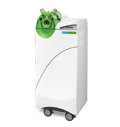THE LCGC BLOG
This time I'm going to be looking at how to get the most from your GC–MS (Gas Chromatography–Mass Spectrometry) system, and I intend to keep things as simple as possible, however I also make no apology in the fact that some of the concepts may be beyond your current understanding. My intention here is to explain some of the basics so that you will be able to use your instrumentation to best effect. Read more
advertisment
New generation Jordi GPC columns prepared with monodisperse 100% DVB particles with precisely controlled particle diameter and finely controlled pore structure provide high efficiency, high separation capacity and low back pressure with greater bed stability. 5μm Resolve columns allow separation from 500 to 3,000,000 g/mol (PS equivalent). For higher molecular weights, up to 12 million, Jordi offers its Resolve DVB 13 μm columns.
 Learn more Learn more
|
|
|
Subscribe
Subscribers can enjoy each full issue of LCGC in print, or via LCGC apps.
subscription offers |

|
|
|
|
|
advertisment

|
|
|
|
advertisment
New! Semi-Reusable BioPureSPN™ TARGA® RPC spin columns, capable of desalting from 100% water, improve recovery of polar molecules prior to LC-MS. For glycans, nucleotides or peptides. Try our color-coded  BioPureSPN TARGA C18 spin columns or cartridges today! The Nest Group, Inc. - "Not Just Columns ... Answers!" BioPureSPN TARGA C18 spin columns or cartridges today! The Nest Group, Inc. - "Not Just Columns ... Answers!"
Featured Articles
The technical requirements for a successful LC–MS/MS method for the quantitation of biopharmaceuticals are presented and the advantages and disadvantages compared to ligand-binding assays are evaluated. Read more
As this study shows, short conditioning steps can be a good way to eliminate carryover in methods using SPME. Read more
The use of off-line 2D-LC–MS for the characterization of HCPs and their monitoring during downstream processing. Read more
Do you produce data or information? Read more
|
|
|
LCGC TV
Paola Dugo from the University of Messina talks about her work using the same stationary phase in both dimensions of a comprehensive 2D LC separation, and how using different gradients in the two dimensions can add to the separation power. Read more
advertisment
While conventional calibration for gel permeation (GPC) and size-exclusion chromatography (SEC) are useful for polymer characterization, there are inherent disadvantages in these analyses. Adding multi-angle light scattering (MALS) detection can help overcome the challenges faced with single-detector chromatography. For more complex polymers, asymmetric flow field-flow fractionation (AF4) offers additional capabilities.  Download the eBook Download the eBook
|
|
|
FEATURED PRODUCT
 |
Innovation sets the new QSight LC/MS/MS apart from other triple quadrupole systems on the market. It's ideal for a wide range of applications, including food safety, environmental testing and industrial research. The QSight LC/MS/MS patented technologies provide high sensitivity, maximum uptime and unparalleled remote support capabilities.  Learn more Learn more |
|
|
|
|
New Webcasts
Tuesday, February 21, 2017
11 am EST | 4 pm GMT | 5 pm CET
Register>>
Wednesday, February 22, 2017
11 am EST | 8 am PST | 4 pm GMT | 5 pm CET
Register>>
Thursday, February 23, 2017
9 am EST | 2 pm GMT | 7:30 pm IST
Register>>
Wednesday, March 8, 2017
11 am EST | 10 am CST | 8 am PST
Register>>
|
|
|
Thursday, March 9, 2017
11 am EST | 4 pm GMT | 9:30 pm IST
Register>>
Thursday, March 23, 2017
11 am EDT | 3 pm GMT | 4 pm CET
Register>>
Wednesday, April 12, 2017
11 am EDT | 8 am PDT | 4 pm BST | 5 pm CEST
Register>>
Tuesday, April 25, 2017
11 am EDT | 4 pm BST | 5 pm CEST
Register>>
|
|
|
|
|
|
|